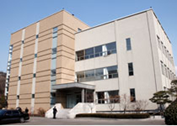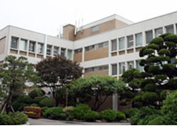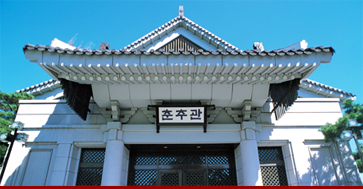PLACE & BUILDINGS
- MAIN BUILDINGS
- YEONGBINGWAN
- SECRETARIAT
- GYEONGMUDAE
- SANGCHUNJAE
- NOKJIWON
- PRESIDENTIAL RESIDENCE
- CHUNCHUGWAN
THE MAIN BUILDING

Before the completion of the current main building, there was widespread concern that it was inappropriate for the president to use the residence once used by the Governor-General during the Japanese colonial era (1910-1945). Following such concerns, an advisory committee was set up during the Roh Tae-woo presidency to carry out the construction of a brand new presidential office and private residence.
The Main Building, which was subsequently completed in 1991, houses the private office of the President and other various function rooms.
The exterior design was based on the architectural techniques used in the construction of traditional wooden royal palaces. The hipped and gabled roof of the building is regarded as one of the most refined and attractive styles of Korean traditional architecture. It features lines converging at the crest of the roof in a triangle. The roof rises on a slant from the tip of eaves to join together at the crest of the roof, forming a hip.
The Main Building and its two annexes are covered with a total of 150,000 traditional Korean blue roof tiles(hence, the name "Blue House" is also commonly used when referring to Cheong Wa Dae). The blue roof tiles are well known for their unique color and their outstanding durability. Following procedures similar to that of making fine pottery, they last for over 100 years and do not become discolored.
The interior of the building features modern amenities and facilities, striking a balance between efficiency, modernity and tradition.
The President's private office is located on the second floor. There are several function rooms and conference halls, including Jiphyeonsil where the President meets with her senior staff or at times holds summit meetings with other Heads of State. Other rooms include Inwangsil, a reception/dining hall and Baegaksil, a private dining hall for smaller meetings. Chungmoosil is used for press briefings following summit meetings or official dinners to honor foreign dignitaries. This is also where accredited ambassadors and heads of missions present their credentials to the President.
YEONGBINGWAN, THE STATE GUEST HOUSE

Yeongbin-gwan was built in 1978.
Before then, receptions for presidential guests were held at downtown hotels, causing much discomfort to the citizens and creating security hazards. The alternative was to build a guesthouse inside the Cheong Wa Dae compound.
The building is supported by 18 granite pillars. The fine quality granite was quarried from Hwangdeung village in Jeollabuk-do (province).
The interior walls of the building are decorated with traditional designs. The designs include the samtaegeuk, a circle divided by three interlocking comma shapes, the Rose of Sharon, which is the national flower of Korea, and the Wolgyesu, or Grecian laurel. The samtaegeuk circle is different from the yin and yang circle found in the Korean flag. The yin and yang circle is divided in two, but the samtaegeuk circle is divided into three. The three parts represent perfect harmony among the three entities of the universe: heaven, earth and human beings.
SECRETARIAT BUILDINGS



The Cheong Wa Dae staff members are housed in three separate buildings called Wimin gwan, which means "serving the people." Of the three buildings, the first one was completed in 1969 and as the number of presidential staff steadily increased over the years, the second (1972) and third (2004) buildings were built adjacent to each other.
The Wimin gwan buildings have various facilities for the staff, such as a common mess hall, library, gym, convenience store, bank and more. The Chief of Staff and other senior advisors to the President as well as the senior secretaries to the President have their offices here. The President has a more intimate personal office located in one of the buildings where she would take care of business on weekends.
Solar panels have been set up on one of the buildings in order to conserve energy and generate electricity to be used by all three buildings.
Next to these buildings is located a helipad where the President's helicopter fleet would take off and land.
GYEONGMUDAE BUILDING

The old main building of Cheong Wa Dae was called Gyeongmudae after the name of the site on which it stood. Thus the site is also often referred to as the "old main building ground." As the back garden of Gyeongbokgung palace during the Joseon Dynasty, this site is known to be more propitious than any other place according to geomancy. It is a spot where the influences of the energy from several mountain ranges converge. No buildings were erected on this site until 1939. It remained an open space only flanked by two pavilions, which no longer exist. Of the two, Yongmundang represented scholar officials and Yongmudang, military officials.
When the Government of the Republic of Korea was established in 1948, Rhee Syng-man, the first President of the Republic, began to use the Japanese Governor-General's residence as the presidential office and residence, which was built on that site. Yun Po-sun, the second President of the Republic, and subsequent presidents followed suit.
However, the building was not spacious enough to house both the presidential office and residence.
Consequently, the Main Office Building of Cheong Wa Dae was newly constructed in a nearby location in 1991. The old building, which was a symbol of Japanese colonial rule, was left vacant. In 1993, President Kim Young-sam ordered that the building be demolished. A stone marker erected at the site indicates that the first presidential office and residence was located there. The small hill was restored when the old building was destroyed to reproduce the original image of the back garden of Gyeongbokgung palace.
At the site of the old main office building, there is a stone monument whose surface reads "Cheonha Jeil Bokji (天下第一福地)," which can be translated as "the most propitious place under heaven." This inscription is one-third the size of the original that was inscribed on a large boulder behind the current presidential residence. It was found during the construction of the building. Judging from the penmanship, it is presumed that it was written some three or four hundred years ago. Although there are no accurate records about who might have engraved these letters on the boulder, two possibilities have been suggested.
First, it is believed to have something to do with Jeong Do-jeon, a great scholar-official, who played a significant role in founding the Joseon Kingdom. Another possibility has to do with a scholar-official, Yi Hyun-no, who was well known for the theory of geomancy in the early Joseon period. They both advocated this site as the location of the new capital.
SANGCHUNJAE

Literally meaning Ever Spring House, Sangchunjae was constructed using lumber obtained from Geumgang red pines aged over 200 years. The trees came from Chunyang, Bonghwa-gun (county) in the southeastern region of the country. Completed in April 1983, the building has been used by the President mainly for holding unofficial meetings and dinners for small groups of foreign dignitaries.
NOKJIWON ("GREEN GRASS") GARDEN

Surrounded by lush gardens, ponds full of exotic carps and more than 120 different types of trees, Nokjiwon garden is one of the most beautiful places within the Cheong Wa Dae compound. The garden was completed in 1968 and today there are commemorative trees planted by previous presidents to celebrate special occasions.
However, the most impressive - and beautiful - tree is called bansong, or umbrella tree, located in the middle of Nokjiwon. The tree is 17 meters in height and is presumed to have been planted sometime around 1850. Four other pine trees growing straight up beside the bansong are called jeoksong, which is a variety of the red pine.
In the old days, the site of Nokjiwon was a small farm where kings themselves cultivated crops in the hope that there would be a good harvest throughout the country. The President would host various outdoor receptions and lunches at the garden for the foreign diplomatic corps, domestic dignitaries and guests from abroad. Special occasions such as Children's Day, Parents' Day and Teachers' Day are celebrated at the garden with outdoor picnics and receptions.
PRESIDENTIAL RESIDENCE

Before the completion of the current private residence, the second floor of the old main office building was used as the presidential residence. As a result, the family quarters were sometimes used for official purposes but the restricted space was inadequate to receive presidential guests. In order to address these problems, the construction of a new presidential residence began in 1989 and was completed on October 1990. Red pines from Myeongju-gun, Gangwon-do (province) were used for this traditional-style building with a half-hipped roof. The presidential residence consists of main living quarters, an annex for receiving guests, a traditional courtyard and detached outer quarters.
The main gate of the residence is a traditional sammun (triple gate), which is commonly used in traditional Korean architecture.
From the front lawn of the residence, one can take in the magnificent view of downtown Seoul. Throughout the years, former presidents added various features and amenities to the residence.
CHUNCHUGWAN, THE PRESS CENTER

Chunchugwan is home to approximately 150 domestic and international correspondents who cover Cheong Wa Dae. The first and second floor of the building has a pressroom and briefing room, respectively. Presidential news conferences and daily briefings are held in the briefing room. Chunchugwan was opened in 1990. Its traditional Korean gabled roof is covered with clay tiles to harmoniously blend in with the surrounding landscape.
The name Chunchugwan originates from the Goryeo and Joseon Dynasties. In those days, Chunchugwan was the Office for Annals Compilation. The name is traceable further back to one of the Five Confucian Classics, titled Chunchu (in Korean pronunciation; in Chinese, Chunqiu; The Spring and Autumn Annals).
It emphasized fair criticism and strict objectivity in recording history.



 INTERNATIONAL
INTERNATIONAL